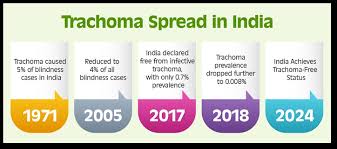
India’s Historic Success in Eliminating Trachoma
India’s Historic Success in Eliminating Trachoma
India has reached a major public health milestone. On May 20 2025, the World Health Organization officially recognized India for eliminating trachoma as a public health problem. Although India had declared trachoma elimination in 2024 based on epidemiological evidence, WHO certification was the final stamp of approval that confirmed this success. With this, India became the third country in the WHO South-East Asia Region to receive this certification, after Nepal and Myanmar. This achievement reflects years of dedicated planning, surveillance, and nationwide health initiatives targeting neglected diseases.
What Is Trachoma?
Trachoma is a contagious bacterial infection of the eye caused by Chlamydia trachomatis. It spreads through close contact, often via hands, clothing, towels, or flies that have come in contact with the eye or nasal discharge of an infected person. If left untreated, repeated infections can lead to scarring inside the eyelid. Over time, this can cause the eyelashes to turn inward and rub against the eye—a painful condition called trachomatous trichiasis. This stage can lead to corneal damage and irreversible blindness.
This disease is currently a public health concern in around 38 countries and has caused visual impairment or blindness in about 1.9 million people globally, making it the leading infectious cause of blindness in the world.
A Preventable Disease with a Clear Strategy
Although trachoma can lead to blindness, it is both preventable and controllable. The WHO recommends the SAFE strategy, a comprehensive approach that stands for:
- Surgery to treat advanced stages like trichiasis
- Antibiotics to clear bacterial infection
- Facial cleanliness to reduce transmission
- Environmental improvement such as better sanitation and access to clean water
India successfully implemented this framework through various public health interventions and campaigns. Key among them is the National Program for Control of Blindness and Visual Impairment, which has been instrumental in early diagnosis, awareness, and treatment efforts.
India’s Success with Neglected Tropical Diseases
Trachoma is part of a group of illnesses known as Neglected Tropical Diseases (NTDs). These diseases are typically found in tropical regions and are often overlooked in terms of research funding and public health attention. NTDs are usually caused by bacteria, viruses, parasites, or fungi. They disproportionately affect low-income populations with limited access to clean water, sanitation, and healthcare.
India has been making steady progress in eliminating several NTDs. So far, three major diseases have been successfully eliminated as public health problems:
- Guinea Worm Disease in 2000
- Yaws in 2016
- Trachoma in 2023 (with WHO certification in 2025)
This achievement highlights India's strong surveillance systems, awareness campaigns, and community-based health efforts.
Disease Classification: Elimination vs. Eradication
It’s important to understand the terms commonly used in public health:
- Eradication means the disease has been completely removed from the world, like smallpox.
- Elimination refers to reducing a disease to below a public health threshold in a specific region, like trachoma in India, which now affects less than 1% of the population.
- Endemic means the disease is still present in a specific area but in controlled levels.
The Role of Environment and Gender
The spread of trachoma is often linked to poor hygiene, crowded living conditions, and limited access to clean water and sanitation. These environmental factors create ideal conditions for the disease to spread. Flies can act as carriers, particularly in areas where facial hygiene is poor and sanitation systems are inadequate.
Women are disproportionately affected by trachoma, often up to four times more than men. This is partly due to their close and frequent contact with children, who are more likely to harbor and spread the infection.
The Linguistic Link to "Trichoma" and "Trichome"
Interestingly, while discussing trachoma, it’s worth mentioning the term trichoma, A word that may appear similar but refers to something completely different. According to dictionaries, trichoma comes from Greek and means “growth of hair.” It is a synonym for trichome, which refers to small, hair-like structures on the surface of plants, algae, and lichens. These structures serve various functions, from protecting the plant from insects to preventing water loss.
Even though “trichoma” and “trachoma” sound alike, they belong to entirely different fields — botany and medicine, respectively. However, the symptom of trachomatous trichiasis, where inward-turning eyelashes (hairs) damage the eye — creates a curious connection between the two terms, as both involve hair-related elements.
Economic and Global Impact
The global burden of trachoma is not just a health concern but an economic one too. The disease contributes to lost productivity and financial burden in affected families and nations. WHO estimates the global productivity loss due to blindness and vision impairment from trachoma at around USD 2.9–5.3 billion each year. When advanced stages like trichiasis are included, this cost may rise to nearly USD 8 billion annually.
Eliminating trachoma, therefore, is not just about reducing blindness. It also lifts a heavy economic burden from poor communities.
Looking Ahead
India's certification marks a moment of pride, but it also sets a standard for continued vigilance. Trachoma elimination does not mean zero cases forever; it means the disease is no longer a public health threat. To sustain this status, health workers must continue monitoring communities, ensuring hygiene education, and maintaining environmental improvements.
India’s success offers a model for other countries still fighting trachoma and other neglected tropical diseases. Through a blend of government support, public cooperation, and international guidance, long-standing diseases can be brought under control, even in the world’s most densely populated regions.